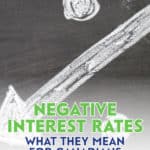What Negative Interest Rates Mean for Canadians

Even before COVID-19 began to dominate the collective consciousness, the possibility of negative interest rates garnered plenty of attention in the press. Just last year, in the midst of a U.S./China trade war, Donald Trump mused about the Federal Reserve heading into negative territory in order to spur the economy. In the EU, several European central banks have used negative interest rates for a number of years now. In light of all of this, not to mention the ultra-low interest rate environment we are currently living in, I thought it would be helpful to explore the subject of negative interest rates – what they mean for the economy, and how they might impact individual Canadians.
The Overnight Rate Explained
To understand how negative rates work, one needs to be familiar with something called the overnight interest rate. This is the interest rate financial institutions use when they lend money to one another for one night. It’s set by the Bank of Canada and is the basis upon which other interest rates, such as mortgages, loans, and lines of credit, are set. When the Bank of Canada drops the overnight rate below zero, the economy enters into negative interest territory. The reason for the Bank of Canada, or any central bank for that matter, to take such a drastic step has to do with boosting economic growth.
How Is Economic Growth Measured?
While there is no shortage of indicators that can indicate the rate of growth of an economy, Gross Domestic Product (GDP) is the standard measurement used by most countries. GDP refers to the total value of goods and services produced in Canada over a specific period of time. The faster GDP rises, the faster the economy grows. To help keep things in check, central banks have the ability to adjust interest rates upwards or downwards. This is considered a mechanism of monetary policy. Of course, it seems fairly obvious why a central bank would want to lower interest rates to encourage growth, but why increase them in hopes of an economic slowdown?
If an economy grows too quickly, the price of everything from houses, vehicles, gasoline, and groceries can outstrip the increase in wages. When this happens, life becomes unaffordable for millions of Canadians who no longer have enough money to maintain the same standard of living. While the economic cycle ensures that there will always be ups and downs, the goal of central banks is to aim for consistent, steady growth.
How Do Negative Interest Rates Work?
The Bank of Canada uses interest rates as a tool to either accelerate or slow the economy. Generally speaking, when interest rates decrease, the cost of borrowing drops and Canadians tend to increase their spending on things like houses and vehicles. The opposite is meant to occur when central banks increase interest. In those instances, the desired result is that Canadians borrow less, resulting in a drop in demand, an increase in supply, and a slowdown overall.
On rare occasions, central banks may take the drastic step of reducing interest rates below zero. This rather extreme measure is designed to force banks to lend money, with the goal of boosting economic activity and consumer spending. Problems can arise in low rate environments when banks, faced with tiny margins on the money they lend out, begin to hoard their cash reserves. These reserves are held with the Bank of Canada, and if banks aren’t lending, Canadians aren’t spending, which means that billions of dollars sitting there, untouched.
Pros and Cons of Negative Interest Rates
If the Bank of Canada were to introduce a policy of negative interest rates, they would obviously hope for a positive outcome. And it’s possible that this may occur. Lenders may be prompted to lend more, and Canadians may start to borrow and spend in such a favourable, low rate environment. However, there can also be downsides to negative interest rates.
As I touched on earlier, negative rates mean that financial institutions must pay money just to maintain their cash reserves. This should motivate them to lend more money, which should lead to an increase in consumer spending and spur the economy. I use the word ‘should’ because unfortunately the desired result isn’t always so easily attained. That’s because financial institutions are always going to be wary of passing along the cost of negative rates to their customer, in the form of lower savings rates or higher fees on deposits.
The banking industry is a competitive one, and any slight increase in fees can send customers elsewhere. That’s the last thing financial institutions want to happen. If banks cannot compensate for the negative interest rates they are paying, they may hold off on new lending, stifling the desired outcome of negative interest rates.
On the personal finance side of things, negative rates mean little to no return on the investment side of the equation. We saw this recently, with the sharp drop in interest rates in the Spring of 2020, as central banks responded to the COVID-19 crisis. While borrowing rates were reduced, rates on savings plummeted suddenly, leaving many investors earning little to nothing in their liquid savings accounts. When this happens, many investors will seek to move funds outside of the country. If you’re borrowing, you’d probably welcome negative rates, but for those with more money in the bank, there’s not much benefit.
I should point out that a negative rate policy tends to have a positive impact on a country’s foreign exchange. As I mentioned earlier, investors tend to move their savings to foreign markets. The result is a decrease in currency value. While not all aspects of currency devaluation are positive, the lower price of a country’s goods will attract interest worldwide, resulting in a positive increase in exports. This, in turn, helps an economy grow.
Negative Rates In the Real World
Much of the conversation around negative rates exists in theory. After all, it’s territory that we rarely venture into here in North America. That said, several foreign countries have been dabbling with negative rates in their monetary policy for years. For example, the European Central Bank introduced negative rates in 2014, and government bond yields in Japan dropped into negative territory as recently as 2016, after their central bank adopted a monetary policy that included negative rates. In Europe, negative rates have resulted in a boost in exports as European currency has become more attractive.
Some may wonder what’s in it for savers. After all, a drop in the interest rate below zero is of far greater benefit to someone who is borrowing money. Well, the majority of Canadians have at least one big loan, called a mortgage, and they’re often paying it off for 20 plus years. If a negative interest rate means that you pay your mortgage down that much faster, that’s a good thing. As far as your savings go, consider moving a larger portion of your savings into investments offering better returns than your typical GIC or savings account, which aren’t even keeping pace with inflation. For example, there are mutual fund and ETF solutions available for traditionally conservative investors.
Final Thoughts on Negative Interest Rates
Negative interest rates are certainly an interesting concept. While we haven’t yet delved below zero here in North America, European central banks have dabbled with negative interest rates for several years now, with mixed results.
When it comes to your personal finances, don’t expect negative rates to result in your bank paying you to borrow money, however, Canadians will benefit from low-interest rates on anything from mortgages to loans and lines of credit. The downside is that investors have little to gain in a negative interest rate environment. In fact, many investors are forced to seek out other opportunities to earn a return on their money, outside of Canada if necessary.
The Bank of Canada has a lot more riding on negative interest rates than the personal savings accounts of Canadians. They have bigger goals in mind. And in these times, when extreme measures may be required to spur the economy, get banks lending, and Canadians spending, no option is off the table.


Comments
I had hoped your article would at least make some explicit remarks about the macro-demographic effects of negative interest rates in terms of shifting monetary support from older Canadians, who tend to spend less and rely more on fixed investment income, to the more heavily-indebted younger age groups who are the economy’s biggest consumers. It would have also been enlightening to highlight the impact of negative rates on the annuities market for seniors. Examining this issue through a demographic lens would have made this analysis more universally informative.